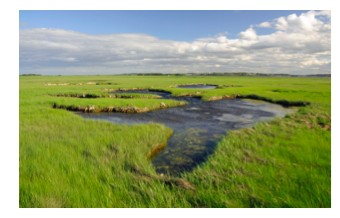North Atlantic Marsh Resiliency Projects

RESPONDING TO THREATS TO TIDAL MARSH COMMUNITIES
How are tidal marsh species and habitats being affected by storms and sea-level rise?
What are the best restoration and management approaches to make these species and habitats more resilient to climate change?
North Atlantic Marsh Resiliency Projects integrate existing data, model, and tools with foundational data and impact assessments to investigate the impacts of climate change on tidal marshes and associated species, and and identify the best opportunities for restoring, conserving, and managing these resources in the face of storm impacts, sea level rise, and other threats.
For an overview of North Atlantic Landscape Conservation Cooperative resiliency projects related to tidal marsh ecosystems, please visit: http://northatlanticlcc.org/projects/tidal-marsh-resiliency/increasing-resiliency-of-tidal-marsh-habitats-and-species
Explore the projects
Designing Sustainable Coastal Landscapes in the Face of Sea-level Rise and Storms
Under a cooperative agreement funded by the Hurricane Sandy Disaster Mitigation Fund, Designing Sustainable Coastal Landscapes in the Face of Sea-level Rise and Storms, will add needed coastally relevant information to the Designing Sustainable Landscapes project for the North Atlantic region.
Decision Support Framework for Sea-level Rise Impacts
One of the principal impacts of sea-level rise will be the loss of land in coastal areas through erosion and submergence of the coastal landscape. However, changes vary across space and time and are difficult to predict because landforms such as beaches, barriers, and marshes can respond to sea level rise in complicated, dynamic ways. This project developed decision support models to address critical management decisions at regional and local scales, considering both dynamic and simple inundation responses to sea-level rise.
Identifying Resilient Sites for Coastal Conservation
Sea levels are expected to rise by one to six feet over the next century, and coastal sites vary markedly in their ability to accommodate such inundation. In response to this threat, scientists from The Nature Conservancy evaluated 10,736 sites in the Northeast and Mid-Atlantic for the size, configuration and adequacy of their migration space, and for the natural processes necessary to support the migration of coastal habitats in response to sea-level rise.
Salt marsh modeling coupled with hydrodynamic modeling
Combining marsh equilibrium modeling approach with a hydrodynamic modeling approach, this coupled model forecasts the evolution of marsh landscapes under different sea-level rise scenarios, with or without marsh restoration and storm surge factored in, to inform future management decisions with regard to system dynamics.
Atlantic and Gulf Coast Resiliency Project
Coastal change is a shared challenge along the Atlantic and Gulf Coasts of the United States, yet there are vast differences in the tools and information available in these regions. This project coordinated, synthesized, and delivered coastal resilience information, activities and lessons learned across the coastal portion of the Atlantic, Gulf and Caribbean Landscape Conservation Cooperative (LCC) network.
Salt marsh Habitat and Avian Research Program (SHARP)
A collaborative effort to assess risks and set response priorities for tidal-marsh dependent bird species from Virginia to maritime Canada.




